 The Argo CTD --
The Argo CTD --
SBE 41 / 41CP CTD Module for Autonomous Profiling Floats
(available exclusively through float manufacturers)

Navis Float
Navis Float with Biogeochemical
(BGC) Sensors
Navis Float with Integrated Biogeochemical
(BGC) Sensors
Compare
features across Navis product line
Other Floats with
Biogeochemical (BGC) Sensors
Introduction
The SBE 41 CTD module was originally developed in
1997 for integration with a sub-surface oceanographic float called ALACE
(Autonomous Lagrangian Circulation Explorer) (Davis,
et. al., 1992). ALACE floats were neutrally buoyant at depth, where they
were carried by currents until periodically increasing their displacement and
slowly floating to the surface. At the surface, the ARGOS satellite system could
determine its current position (http://www.argosinc.com/system_overview.htm).
The long time-series of successive position data on hundreds of individual
floats gave insights into deep ocean circulation.
Early in the evolution of ALACE floats, researchers added
temperature and conductivity sensors to the float to obtain a
temperature/salinity profile during the float's ascent to the surface. The ALACE
float soon became known as PALACE (Profiling ALACE), and
PALACE floats transmitted temperature and salinity data in addition to providing
drift track data. However, the quality of the salinity data on early PALACE
floats deteriorated quickly due to fouling. The Sea-Bird SBE 41 CTD module was
developed in response to the scientific need for highly accurate salinity
measurements that remained stable for the three to five year operational life of
the PALACE float. The results have been truly remarkable. Today, SBE 41s are
producing salinity data accurate to within 0.005 [PSU] for more than 3 years.
The value of near-real-time oceanographic data transmission from multiple floats
is evidenced by the ability of oceanographers to monitor and predict the
influence of El Niño weather patterns on the surface of the North Atlantic Ocean
(Riser, 1998).
The success of PALACE floats and the SBE 41 led to the
Argo Program, which began in 1999 (http://www.argo.ucsd.edu/).
The program goal was to establish and maintain a working population of 3000
floats dispersed throughout the world, transmitting near-real time temperature
and salinity from the upper 2000 meters of the ocean. That goal was reached by
the end of 2007; there are more than 3400 deployed floats as of May 2012, as
shown on the float distribution map below.
Today, Sea-Bird manufactures approximately 1000 SBE
41/41CP CTDs per year, supplying more than 90% of the annual Argo program
requirement as well as a growing market in non-Argo float applications.
|
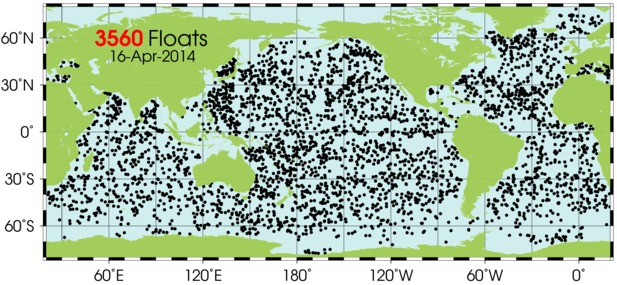 |
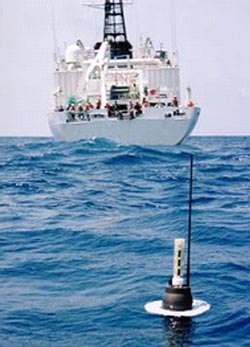
Float deployment from vessel |
Features and Specifications of the SBE 41/41CP Design
- The SBE 41/41CP uses the proven MicroCAT Temperature, Conductivity,
and Pressure sensors. The CTD is shipped fully calibrated, and has demonstrated
excellent long-term stability, eliminating the need for post-deployment
tampering of the calibration to force agreement with the local TS.
|
Sensor |
Calibration
Standard |
Accuracy |
Stability |
|
Temperature |
ITS-90 |
± 0.002 deg C |
0.0002 deg C/year |
|
Conductivity |
IAPSO Standard Seawater |
± 0.002 (equivalent salinity) |
0.001 / year (equivalent salinity) |
|
Pressure |
Deadweight tester & pressure reference |
± 2 dbar |
0.8 dbar / year |
|
|
|
|
|
- The SBE 41/41CP has carefully engineered anti-foul
protection, with anti-foulant devices, a U-shaped flow path, and a pump.
- On the float’s ascent, as the float approaches 10 – 5 decibars beneath the
ocean’s surface, the pump turns off. The U-shaped flow path prevents sea
surface oils and contaminants from being ingested while proceeding through
the ocean surface skin and sitting at the surface during data transmittal.
- Between profiles the pump is off. The U-shaped flow path prevents water
flow through the system caused by waves or currents; minute amounts of
anti-foulant concentrate inside the conductivity cell to minimize
bio-fouling.
- The SBE 41/41CP has proven TC-Ducted flow over the temperature sensor and into the conductivity sensor. Salinity spiking is minimized because the
TC-Duct and pump precisely coordinate the T and C responses.
- The SBE 41/41CP premium strain-gauge pressure sensor has thermistor correction for ambient
temperature effects.
- The SBE 41 pump delivers 40 ml/sec flow for 2.5 seconds per measurement of T, C, & P, and exhausts
through a zero-thrust port.
The SBE 41CP pump delivers 10 ml/sec flow continuously during the
profile.
The CTD sensors and electronics (shown below) are mounted to an
Argo top end cap
(satellite whip antenna not shown).
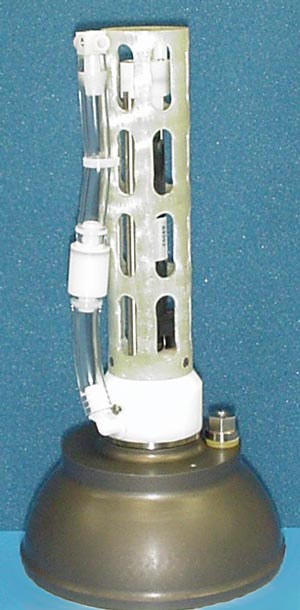
Photo A: Sea-Bird CTD module with guard installed. |
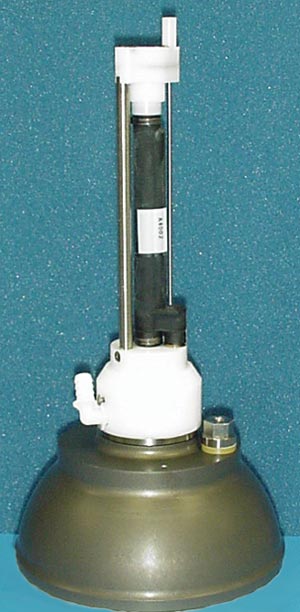
Photo B: Module with guard removed to show conductivity cell. |
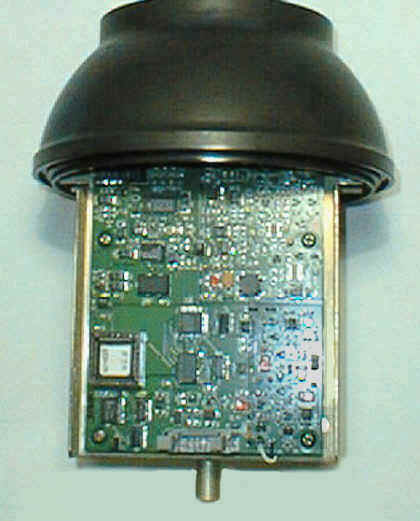
Photo C: Module showing mounted PCB. |
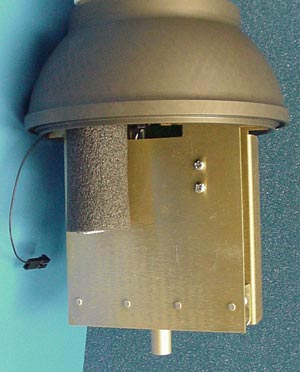
Photo D: Opposite side of Photo C, showing pressure sensor.
|
SBE 41 or 41CP?
Both the SBE 41 and 41CP measure conductivity,
temperature, and pressure, and can be equipped to also measure dissolved oxygen
(see Recent Developments below). The sensors on the SBE 41 and 41CP are
identical; the difference lies in the circuitry and sampling protocols:
- The SBE 41 spot samples on command. It
has no internal memory, and transmits the data to the float controller as
each measurement is made. The float controller stores the data, and
transmits it when the float reaches the surface. This system is typically
used with low bandwidth satellite telemetry such as Argos, which can
accommodate only a limited stream of data.
- The SBE 41CP is designed to perform a Continuous
Profile, sampling at 1 Hz as the float ascends to the surface, and
storing the data in internal memory. The float controller requests and
transmits the data when the float reaches the surface. The SBE 41CP can spot
sample on command in addition to / in combination with continuous sampling.
For example, a float can be programmed to spot sample in deep water, where
parameters of interest are fairly stable, and then to perform a continuous
profile as the float ascends through shallower depths, providing the desired
level of detail while minimizing the data to be transmitted.
For both the SBE 41 and 41CP, the system can be programmed
to transmit all the data, or just the parameters of interest (C, T, P; T and P;
P only; or C, T, P, and D.O.).
Additional Sensors
-
SBE 63 Optical Dissolved
Oxygen Sensor integrated with Argo CTDs
The SBE 63, in production since 2011, can be integrated with SBE 41/41CPs on
several float types, including a Sea-Bird Navis
Float. Currently, the SBE 63 requires an RS-232
interface in the float controller; a fully integrated version (eliminating
the need for the RS-232 interface in the controller) is expected to be
available at a future date.
- Biogeochemical Sensors
Biogeochemical sensors, such as the
WET Labs ECO
Triplet, can be integrated with the SBE 41CP on several float types,
including a Sea-Bird Navis Float. The ECO
Triplet is three sensors in one, providing any combination of fluorescence
(chlorophyll, CDOM, phycoerythrin, phycocyanin, rhodamine, or uranine) and
scattering (blue , green, or red) measurements.
- Surface Temperature and Salinity Sensor (STS)
integrated with Argo CTDs
The trade-off for achieving sensor stability
over the lifespan of the Argo floats was the forfeiture of very near surface
temperature and salinity information to prevent ingestion of sea surface
oils and contaminants into the conductivity cell. With increasing interest
in measuring surface salinity in the world’s oceans, Sea-Bird developed an
integrated system that continues to gather high accuracy salinity and
temperature data using the pumped SBE 41CP CTD between 2000 – 5 decibars,
while co-deploying a free-flow sensor called STS in the upper 20 db to
capture the surface temperature and salinity conditions. STS is a
free-flushing sensor, and is expected to ingest sea surface oils and
contaminants that may alter the sensor calibration over time. To correct any
drift in STS, both the SBE 41CP CTD and the STS take measurements near the
float park depth and again in the upper ocean, just before the SBE 41CP pump
is turned off, and then STS continues sampling through the ocean surface.
STS data can then be corrected by recalibrating it based on the comparison
measurements to the clean data from the SBE 41CP (more
details).
SBE 41/41CP Manufacturing and Calibration
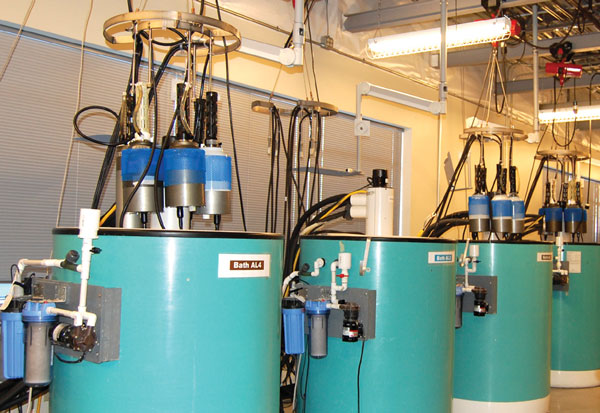
Argo CTD Calibration Baths (4 of 6 shown)

Argo "CTD heads" in various stages
 Additional Information
Additional Information
(At right, Module mounted on a float at Webb Research)
References
- Davis, R.E., D.C. Webb, L.A. Regier, and J. Dufour (1992) "The
Autonomous Lagrangian Circulation Explorer (ALACE)", Journal of Atmospheric and
Oceanic Technology, V9, 264-285.
- The Argo Science Team (Dean Roemmich [chair],
Olaf Boebel, Howard Freeland, Brian King, Pierre-Yves LeTraon, Robert Molinari,
W. Brechner Owens, Stephen Riser, Uwe Send, Kensuke Takeuchi, Susan Wijffels), "On
the Design and Implementation of Argo, A Global Array of Profiling Floats".
- Riser, S.C. (1998). "The Distribution of
18-Degree Water in the North Atlantic During the Autumn of 1997 and the Winter of
1988", AGU 1998 Ocean Sciences Meeting Presentation OS11J-04.
![[HRule Image]](../../images/div.gif)
Specifications are subject to change without notice.
Sea-Bird Home Phone: (+1) 425-643-9866
E-mail:
seabird@seabird.com
 The Argo CTD --
The Argo CTD -- The Argo CTD --
The Argo CTD --![]()







![]()